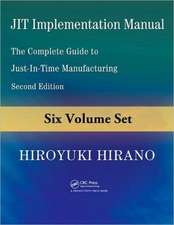It's About Time: The Competitive Advantage of Quick Response Manufacturing
Autor Rajan Surien Limba Engleză Hardback – 31 mar 2010
1. The Power of Time – the huge impact time has on your entire enterprisePresenting new case studies on QRM implementation, It's About Time: The Competitive Advantage of Quick Response Manufacturing illustrates how QRM can not only reduce lead times but also improve quality, reduce operating costs, and enable companies to gain substantial market share. This practical reference explains how factories in advanced nations can use QRM strategy to compete with manufacturers in low-wage countries. In addition, it provides helpful pointers for QRM implementation, including accounting strategies, novel cost-justification approaches, and a stepwise process for implementation.
2. Organization Structure – how to structure your organization to reduce lead times
3. System Dynamics – understanding how interactions between jobs and resources impact time to make better decisions on capacity, lot sizes, and similar issues
4. Enterprise-Wide Application – QRM is not just a shop floor strategy, it extends across your whole enterprise including material planning and control, supply management, office operations, and new product introduction
Also included are downloadable resources with five appendices that provide a number of practical details to assist in the success of your QRM implementation. When you are ready to start implementing QRM, you will find that these appendices contain time-saving tips to help you work through implementation issues¿including simple calculation methods and tools to support the design of your QRM strategy. You can also access these Appendices on the Downloads and updates tab on https://www.crcpress.com/9781439805961.
The author, Rajan Suri, recently became one of only 10 people to be inducted into Industry Week's 2010 Manufacturing Hall of Fame.
Preț: 319.20 lei
Nou
Puncte Express: 479
Preț estimativ în valută:
61.08€ • 63.94$ • 50.54£
61.08€ • 63.94$ • 50.54£
Carte tipărită la comandă
Livrare economică 05-19 aprilie
Preluare comenzi: 021 569.72.76
Specificații
ISBN-13: 9781439805954
ISBN-10: 1439805954
Pagini: 228
Ilustrații: 27 black & white illustrations, 7 black & white tables
Dimensiuni: 156 x 234 x 18 mm
Greutate: 0.48 kg
Ediția:1
Editura: Taylor & Francis
Colecția Productivity Press
Locul publicării:Oxford, United Kingdom
ISBN-10: 1439805954
Pagini: 228
Ilustrații: 27 black & white illustrations, 7 black & white tables
Dimensiuni: 156 x 234 x 18 mm
Greutate: 0.48 kg
Ediția:1
Editura: Taylor & Francis
Colecția Productivity Press
Locul publicării:Oxford, United Kingdom
Public țintă
Professional Practice & DevelopmentCuprins
The Power of Time. Organizational Structure for Quick Response: QRM Cells, Teamwork, and Ownership. Understanding and Exploiting System Dynamics Principles. A Unified Strategy for the Whole Enterprise. A Roadmap for QRM Implementation. Index. About the Author. Bonus CD: Appendix A: Tips for Calculating Manufacturing Critical-Path Time (MCT) and Creating MCT Maps. Appendix B: Practical Examples of Focused Target Market Segments (FTMS). Appendix C: Examples of How to Think Outside the Box When Creating Quick Response Manufacturing (QRM) Cells. Appendix D: Simple System Dynamics Calculations for Quick Insights. Appendix E: Implementing POLCA: The Material Control System for Low-Volume and Custom Products.
Notă biografică
Rajan Suri is Emeritus Professor of Industrial Engineering at the University of Wisconsin–Madison. He received his Bachelors degree from Cambridge University (England) in 1974, and his M.S. and Ph.D. from Harvard University in 1978. Dr. Suri founded and served as Director of the Center for Quick Response Manufacturing (QRM) from 1993 to 2008, and continues to serve the Center in an advisory role. The Center is a consortium of companies working with the University on developing and implementing QRM strategies—over 200 companies have worked with and supported the activities of the Center (www.qrmcenter.org).
Suri introduced the core concepts of QRM in his landmark book Quick Response Manufacturing: A Companywide Approach to Reducing Lead Times (Productivity Press 1998). He is also author of over 100 technical publications, has chaired several international conferences on manufacturing systems, and has served on the editorial boards of leading scholarly journals in the field. Dr. Suri combines his academic credentials with considerable practical experience. He has consulted for leading firms including 3M, Alcoa, AT&T, Danfoss, Ford, Hewlett Packard, Hitachi, IBM, Ingersoll, John Deere, National Oilwell Varco, P&H Mining Equipment, Pratt & Whitney, Rockwell Automation, Siemens and TREK Bicycle. Consulting assignments in Europe and the Far East, along with projects for the World Bank, have given him a substantial international perspective on manufacturing competitiveness.
In 1981, Dr. Suri received the Eckman Award from the American Automatic Control Council for outstanding contributions in his field. He was a member of the team that received the 1988 LEAD Award from the Society of Manufacturing Engineers. He is coauthor of a paper that won the 1990 Outstanding Simulation Publication Award from The Institute of Management Sciences. In 1994, he was co-recipient of the IEEE Control Systems Technology Award. In 1999, Suri was made a Fellow of the Society of Manufacturing Engineers (SME), and in 2006, he received SME’s Albert M. Sargent Progress Award for the creation and implementation of the Quick Response Manufacturing philosophy.
Rajan Suri recently became one of only 10 people to be inducted into Industry Week's 2010 Manufacturing Hall of Fame.
Suri introduced the core concepts of QRM in his landmark book Quick Response Manufacturing: A Companywide Approach to Reducing Lead Times (Productivity Press 1998). He is also author of over 100 technical publications, has chaired several international conferences on manufacturing systems, and has served on the editorial boards of leading scholarly journals in the field. Dr. Suri combines his academic credentials with considerable practical experience. He has consulted for leading firms including 3M, Alcoa, AT&T, Danfoss, Ford, Hewlett Packard, Hitachi, IBM, Ingersoll, John Deere, National Oilwell Varco, P&H Mining Equipment, Pratt & Whitney, Rockwell Automation, Siemens and TREK Bicycle. Consulting assignments in Europe and the Far East, along with projects for the World Bank, have given him a substantial international perspective on manufacturing competitiveness.
In 1981, Dr. Suri received the Eckman Award from the American Automatic Control Council for outstanding contributions in his field. He was a member of the team that received the 1988 LEAD Award from the Society of Manufacturing Engineers. He is coauthor of a paper that won the 1990 Outstanding Simulation Publication Award from The Institute of Management Sciences. In 1994, he was co-recipient of the IEEE Control Systems Technology Award. In 1999, Suri was made a Fellow of the Society of Manufacturing Engineers (SME), and in 2006, he received SME’s Albert M. Sargent Progress Award for the creation and implementation of the Quick Response Manufacturing philosophy.
Rajan Suri recently became one of only 10 people to be inducted into Industry Week's 2010 Manufacturing Hall of Fame.
Recenzii
Suri's work is refreshingly logical. And for a book having fewer than 200 pages, it's incredibly comprehensive, covering shop floor part flow; the front office; engineering; new-product development; scheduling; supplier strategies; and even basic accounting issues, including an insightful discussion of how a shop allocates overhead and the effect it has on shop operations.
Most refreshing of all, not once does Suri mention anything about 'doing more with less.' Under QRM, if demand rises, companies should indeed invest in machines and people to build in that excess capacity and ensure utilization doesn't head into dangerously high territory. QRM does demand that workers perform myriad functions, set up more often, and manage product flow. But it doesn't demand that they put in long hours to get the job done. During a time when so many companies are reluctant to add to their payrolls, that's a powerful message.
-Tim Heston, Senior Editor, FMA Communications Inc., in The Fabricator, October 2011
Most refreshing of all, not once does Suri mention anything about 'doing more with less.' Under QRM, if demand rises, companies should indeed invest in machines and people to build in that excess capacity and ensure utilization doesn't head into dangerously high territory. QRM does demand that workers perform myriad functions, set up more often, and manage product flow. But it doesn't demand that they put in long hours to get the job done. During a time when so many companies are reluctant to add to their payrolls, that's a powerful message.
-Tim Heston, Senior Editor, FMA Communications Inc., in The Fabricator, October 2011
Descriere
Presenting the developments in QRM since the publication of Rajan Suri’s landmark text, Quick Response Manufacturing, this book illustrates how QRM can not only reduce lead times but also improve quality, reduce operating costs, and enable companies to gain a substantial market share. It explains how factories in advanced nations can us




![Using Hoshin Kanri to Improve the Value Stream [With CDROM]: From Theory to Practice](https://i3.books-express.ro/bt/9781420084238/using-hoshin-kanri-to-improve-the-value-stream-with-cdrom.jpg)















